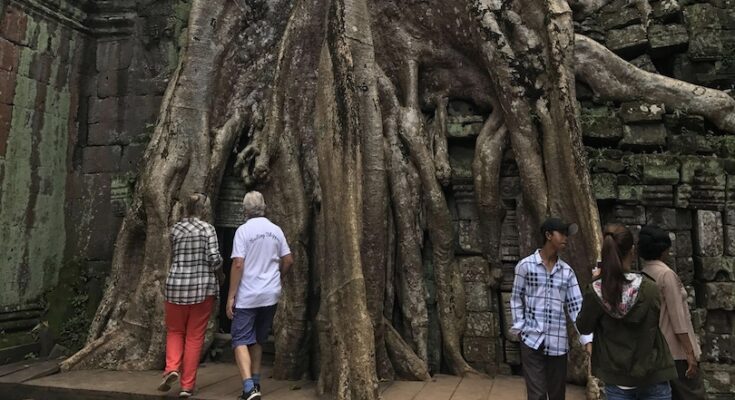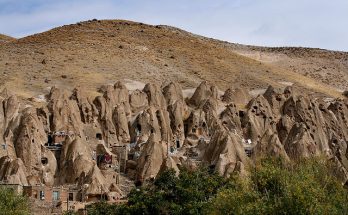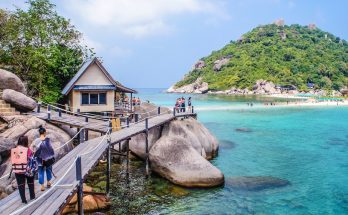A few years ago, I joined my adventurous grandmother on a trip to Vietnam and Cambodia, two of her favorite South East Asian countries. We were following a jam-packed itinerary through some of the most beautiful cities and significant monuments in the area, but none stood out as much as Ta Prohm temple in Cambodia.
While Angkor Wat is undoubtedly the crowning jewel of Cambodia’s ancient temples, this is just one of many in the Angkor Archeological Park. To put things into perspective, the complex houses 72 major temples and hundreds of other smaller archeological temple sites, which, once upon a time, were all part of the capital of the Khmer Empire.
Disclaimer – Angkor Wat was the main purpose of our visit. However, since my travel companion knew the area like the back of her hand, she had a few recommendations about which other temples were worth exploring.
In this post, we’ll cover:
Angkor Archeological Park

Our plan was to visit the lesser-known temples of the complex as a lead-up to the main event – a day at Angkor Wat. We purchased a three-day pass to the Angkor Archeological Park for $62, giving ourselves plenty of time to immerse ourselves in the Ancient Khmer Empire.
On our first day, we visited Roluos, a Khmer civilization built in the 8th and 9th centuries consisting of three temples: Bakong, Lolei, and Preahko. We then visited the Bayon Temple, a 12th-century masterpiece known for its 54 towers carved with faces representing the 54 provinces of the Khmer Empire.
We ended the afternoon at one of my personal favorite temples, Banteay Srei, which is a ‘Citadel of the Women’ and one of the best-preserved in Cambodia. Unlike any other temple in Angkor, this temple was built using carved pink sandstone.
Our second day was spent exploring the Hindu-Buddhist Angkor Wat temple, which is so impressive it deserves its own post.
On our third and final day in Siem Reap, we set out on a sunrise adventure into the jungle-clad Ta Prohm, one of the most picturesque of the Angkor Temples.
Reflecting on our journey, each temple we visited had a distinct charm, held its own historical significance, and left a lasting archeological impression. However, Ta Prohm stood out as the most memorable.
History of Ta Prohm

The Angkor Wat temples served as the royal capital of the Khmer dynasty, during a time where Khmer Kings ruled one of the largest, most prosperous, and sophisticated civilizations in Southeast Asia.
Ta Prohm was built in the late 12th century by King Jayavarman VII as a dedication to his mother. Originally a Buddhist monastery, the temple stands testament to the architectural prowess of the Khmer Empire.
In 1431, the temple complex fell to the city of Ayutthaya (modern-day Thailand). The once majestic city was then abandoned and, over time, hidden by the surrounding jungle before being rediscovered in the early 20th century.
Strangled by silk cotton and fig trees, Ta Prohm’s otherworldly appearance shows an incredible relationship between manmade structures and nature.
It was one of the few temples to be preserved exactly how it was found, giving us a sense of what the entire temple complex might have looked like when those European archeologists stumbled across it.
And in more recent history, you might have heard of Ta Prohm as the Tomb Raider Temple, made famous by the iconic film shot in the temple starring Angelina Jolie as Lara Croft.
Guides and Drivers

We were staying in a boutique hotel in the city of Siem Reap, which is the base for exploring the fabled ancient Khmer capital. Ta Prohm temple is located 12 km northeast of Siem Reap and just 3 km from the main Angkor Wat temple.
The drive from Siem Reap to the temple takes between 15 and 25 minutes. There is no public transport in the area, so booking a private driver is necessary. We had a driver and a local guide accompany us through all of the main temples, which made all the difference. Our guide provided historical insights and showed us hidden gems that no guidebook would have been able to.
Another option would be to hire a tuk-tuk driver and guide with extensive knowledge of the temples. You could hire a tuk-tuk for around $20 per day or rent a car with a driver for between $30 and $40 per day.
To benefit from the insights of a local English-speaking guide, do yourself a favor and pay a guide around $35 to spend the day with you (8 am to 5 pm). If you want to see the sunrise from Angkor Wat or Ta Prohm, which I highly recommend, you’ll have to pay an additional $5 to $10 for the extra hours. Worth it!
Tickets and Logistics

As mentioned, we had purchased a three-day pass to the Angkor Archeological Park, costing $62 each and allowing us to enter most of the temples in the area.
There is also an option for a one-day pass for $37 or a seven-day pass for $72, but I think three days was the perfect amount of time to visit plenty of temples and still leave wanting more.
The three-day pass is valid for ten days from the issue date, which means you don’t have to visit the complex on consecutive days.
To get your ticket, you need to physically visit the ticket office to take an identification photograph. It’s open between 4:30 am and 5:30 pm and is just a short drive from the center of Siem Reap.
We visited the ticket office the afternoon we arrived in the city so we wouldn’t have to waste any time on our three temple hopping days!
Most of the temples open their gates from 7:30 am to 5:30 pm. Angkor Wat and a few others open from 5 am, making it possible to view sunrise from the iconic moat.
We visited in November, which falls in Cambodia’s dry season. For obvious reasons, this is the most popular time to visit, but this also means it is the busiest. The wet season may bring rain, but it also brings benefits like reduced humidity, lush jungle scenery, and fewer crowds.
Remember that the ruins and city of temples are a Buddhist holy site, which means visitors are asked to dress respectfully with clothing that covers your knees and shoulders.
I recommend wearing flowing clothing that can keep you cool, your most comfortable sneakers, a sun hat, and bringing along plenty of water and sun cream.
Exploring Ta Prohm

Finally, it was time to explore the temple and its hidden secrets, swallowed by a jungle for centuries. When we reached the eastern gates of the temple, the overgrown root systems were a stark reminder of nature’s relentless claim on the past.
Our driver dropped us off at the entrance, where we continued the journey by foot along a stone-paved path lined with trees. Immediately setting the mystical tone of the day, the entrance led to an outer courtyard where the remnants of fallen walls surrounded us. Our guide directed us through narrow passageways and chambers, each one unveiling the remains of the ancient monastery. The Hall of Dancers had some of the best-preserved carvings.
I’m not sure how we would have navigated the temple without our trusty guide, who had a story for each intricate carving, fallen stone, and twisted root that was more interesting than the next.
The first thing our guide told us was not to veer off the path and designated walkways. While my initial thought was that I might fall into an ancient tomb, he was actually referring to landmine remains that have scattered the region since the civil wars of the 20th century.
While it is possible to breeze through the complex in an hour or so, I recommend dedicating half a day to this archeological gem. Not only will this allow you proper time to learn about the history and significance of the temple, but also to truly absorb the mystique of the labyrinthine corridors, stones suffocated by roots, and unique jungle atmosphere. Just the sounds of the tropical birds alone were enough to keep me occupied for hours.
After at least three hours at the temple, we ventured a fifteen-minute walk towards the parking lot, where our driver was waiting for us with some much-needed air-conditioning. There aren’t any dedicated cafes within the temple grounds, but there are casual vendors who set up shop in the parking lot, selling cold drinks and snacks.
Past, Present, and Future

As I walked through the complex, I could only imagine what the monastery might have looked like in its heyday. With no winding tree trunks and strangling roots, floors and ceilings intact, and ornately carved stones, you can’t help but think, how did such a magnificent structure become totally engulfed by the forest?
Well, one reason is that the temple was made from huge carved stones balanced without mortar, so any tree growing nearby was bound to grow through the building instead of around it.
Still today, the exact reason why these temples were abandoned are unknown. Archeologists and ecologists agree that it was likely due to heavy rains, disease, and drought brought on by early onset climate change.
If I came away from this day-trip with anything, it was that the entire temple is a haunting reminder of how nature is more powerful than human civilization.
My visit to Ta Prohm was more than just a trip to an archeological site; it was a journey through time that really prompted me to think about what our future civilizations might look like hundreds of years from now.



